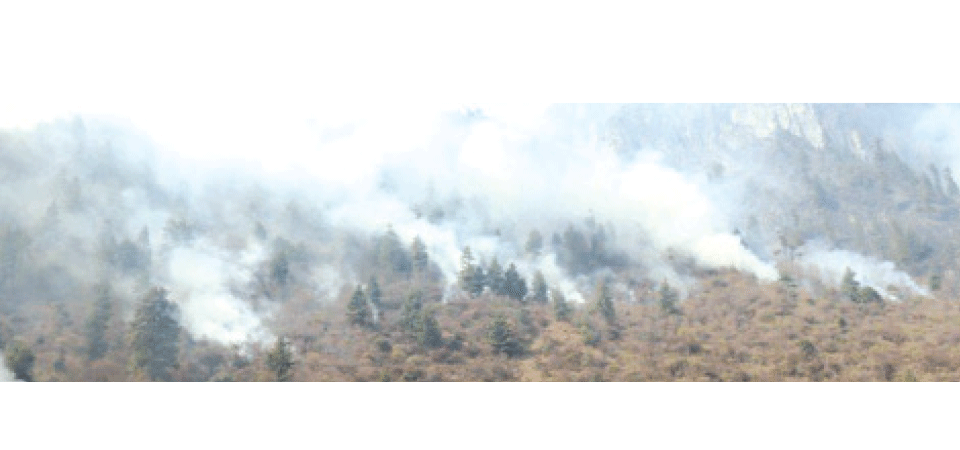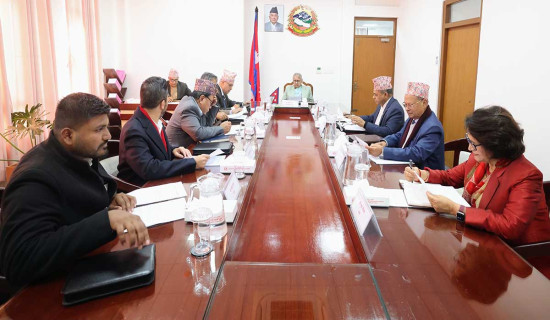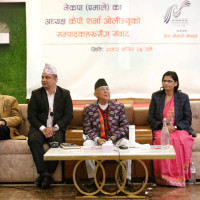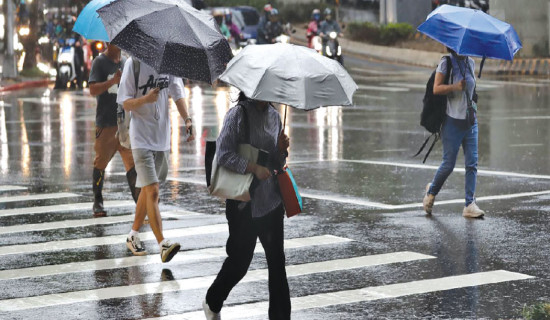- Thursday, 11 December 2025
Bush fires make Valley air unhealthy
Kathmandu, Apr. 14: Suresh Thapa, a Pathao rider in Kathmandu, has been experiencing a burning sensation in his eyes for the past few days.
A full-time rider, Thapa, these days find it difficult to ride his motorcycle in the afternoon. “I work from the morning to evening and my eyes hurt badly when I return home. I don’t know what is happening to my eyes, I am planning to go check my eyes soon,” Thapa, who hails from Sindhupalkwok, said.
Pralhad Mishra did not go for his morning walk from his home near Baglamukhi, Lalitpur, to Chovar on Wednesday and Thursday because of pollution. “The air is unbreathable,” he said. “As soon as I left the house, I felt the air was heavy. My eyes got watery. The surroundings also looked smoky and hazy. I didn’t think it would be healthy for me to walk.”
The air pollution level in Kathmandu Valley reached unhealthy levels on Thursday, ranking among the top five positions in the world.
The IQ Air showed that Nepal was behind Shenyang, China (AQI 167), Chiang, Thailand (AQI 174), Tehran, Iran (AQI 238) and Beijing, China (AQI 491) on Thursday.
The AQI inside the Kathmandu Valley measured at 170 in Adhikarigaun, 159 in Sarasuretisthan, 166 in Sallaghari, 156 in Balkot in Bhaktapur, 160 in Bhaisepati, 163 in Chunne Pakha, Kathmandu, 162 in Tarkeshwor and 160 in Dakshinkali on Thursday afternoon.
The current PM2.5 (tiny particles or droplets in the air that are two and one-half microns or less in width) concentration in Kathmandu on Thursday was seven times above the recommended limit given by the WHO 24-hour air quality guidelines value.
As per the US parameter, AQI between 0 and 50 is considered good air, 51 and 100 is moderate, between 101 and 150 is unhealthy for sensitive groups, between 151 and 200 is unhealthy, between 201 and 300 is very unhealthy and between 301 and 500 is hazardous.
To wash out pollution, there should be good showers, but there is no chance of precipitation very soon, said Pratibha Manandhar, a senior meteorologist at the Meteorological Forecasting Division under the Department of Hydrology and Meteorology.
With increasing bushfires, the pollution level in Kathmandu Valley is increasing because of its bowl shape, making it difficult for the air to pass through. Even if there is wind blowing, it will be hard to clear the pollution level as there is a continuous forest fire, Manandhar said.
Currently, the cloud is covered with haze and mist due to the smoke. There was a minimum 2500 meters of visibility on Thursday morning and could not go beyond 6000 metres due to the haze in the afternoon and mist in the morning, she added. According to the National Disaster Risk Reduction and Management Authority (NDRRMA), there were 288 forest fires recorded over the past week across the country.
Govinda Lamichhane, Environment Inspector at the Department of Environment, attributed the current rise in pollution to the bushfires. The smoke from the bushfires entered the Valley on Tuesday. Districts including Chitwan, Makawanpur, Rupandehi, Dang, Arghakhachi, Pyuthan, Palpa, Gulmi, Bardiya, Parsa, Kanchanpur, Jajarkot, Doti, Kalikot, Syangja, Kapilvastu and Gorkha are witnessing excessive forest fires over the last few weeks.
Districts outside the Valley include Chitwan, Makawanpur and Dhanding are also facing a hard time due to pollution, but pollution measurement stations are not working in many districts except Dhankuta, so the department has failed to measure the pollution level, Lamichhane said.
There are a total of 27 pollution measurement stations across the country, but only nine, including eight in Kathmandu, are working. “The department is working to repair those stations within a few months,” he said.
The department also issued a press release on Wednesday asking people to be alert while coming out from home as the pollution level increases in the Valley due to forest fires. Older people, children and people with the respiratory problem should remain alert as they are more vulnerable to air pollution, the department said in the release.
It also appealed to the concerned authorities to join hands to control the forest fires.
















